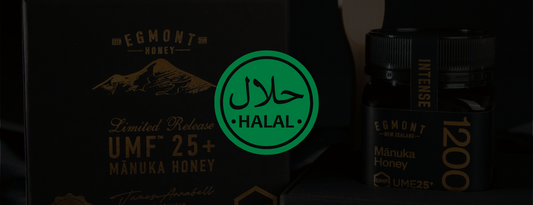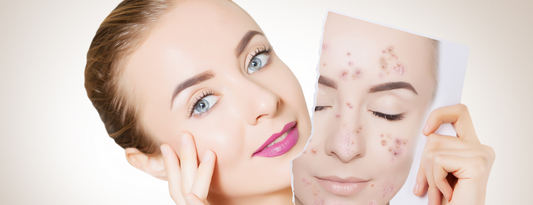If you are exploring natural options for breakouts, you have likely considered Manuka honey for acne. Manuka honey is a unique monofloral honey from New Zealand, prized for its antibacterial and soothing properties. Many people use it to calm inflamed spots, support the skin barrier, and reduce visible redness. This guide explains how Manuka honey for acne works, how to choose a genuine jar, and safe, practical ways to use it at home.
Manuka Honey for Acne - Table of Contents
What makes Manuka honey different
Most honeys rely mainly on hydrogen peroxide for antibacterial activity. Manuka honey also contains methylglyoxal, often abbreviated to MGO. This compound is stable and remains active on the skin surface, which helps to explain the growing interest in Manuka honey for acne compared with ordinary honey.
Laboratory research shows that higher MGO content generally correlates with stronger antibacterial action. While much of the evidence is in vitro or in wound models, these findings support the rationale for using authentic, tested Manuka.
Authenticity matters. New Zealand’s Unique Manuka Factor Honey Association created the UMF quality mark to verify origin, potency, and purity across key compounds such as MGO, DHA, and leptosperin.
Best Sellers on Manuka Hut
How Manuka honey may help acne prone skin
-
Antibacterial support: Manuka honey shows broad antibacterial effects in laboratory settings. This includes activity against microbes relevant to skin, which is one reason people try Manuka honey for acne as a complementary step.
-
Anti inflammatory comfort: Acne lesions are inflamed. Honey has been studied in wound care, where it can provide a moist, soothing environment that favours repair.
- Humectant hydration: Honey is a humectant that draws water into the outer layer of the skin. Better hydration can make skin feel more comfortable, especially if you also use actives like benzoyl peroxide or retinoids that increase dryness.
Where Manuka honey fits in clinical acne care
Manuka honey for acne fits as a calming, consistency step that helps the skin feel comfortable while breakouts settle. Use it as a short-contact cleanse or a ten-minute mask on days when skin feels tight or reactive, aiming for small, steady improvements in hydration and visible redness.
Choose a verified UMF-certified jar so potency and origin are authenticated, since Manuka’s antibacterial profile is linked to methylglyoxal and rises with higher MGO in lab studies (PLOS One; MDPI Cosmetics).
Evidence for honey is strongest in soothing and wound environments, which helps explain its comfort role rather than a curative one.
REMEMBER: Keep expectations grounded and let honey complement a routine that follows accepted clinical guidance for acne care rather than replace it; for context, see the UK NICE acne guideline and a recent summary of American dermatology guidance in JAAD.
Patch test first, use a thin layer, rinse with lukewarm water, and reassess after two to three weeks for calmer mornings and a more balanced feel.

Choosing the right jar
-
Look for the UMF mark: The UMF trademark confirms that the honey meets strict standards for authenticity and potency. This reduces the risk of adulteration and gives confidence in what you are applying to your skin. Details are available at UMFHA.
-
Match strength to the job: Many users choose UMF 10+ to UMF 15+ for leave on or short contact routines. Higher grades contain more MGO and may feel richer or stickier. There is no clinical trial that defines an exact best grade for acne, so select a level that balances potency with comfort.
- Buy from trusted sellers: Counterfeit manuka exists in many markets. Manuka Hut is a dedicated reseller of UMF certified manuka honey and links to verification resources so you can check licences and batch information before you buy.
Our Top Brand: Manuka Health
How to use Manuka honey safely
1) Patch test first: Apply a small amount behind the ear or on the jawline for 24 hours, then repeat. Do not use if you have a known allergy to honey or bee products.
2) Short contact cleanse: On damp skin, massage a small amount of Manuka honey for 30 to 60 seconds, then rinse with lukewarm water. Follow with a gentle moisturiser.
3) Ten minute mask: Apply a thin layer to clean, dry skin. Leave for 10 to 15 minutes, then rinse and pat dry. Start two to three times per week and adjust based on comfort.
4) Spot treatment: Dab a tiny amount on an individual blemish after cleansing. Leave for 10 minutes, then rinse. Increase contact time gradually if well tolerated.
5) Separate from actives: Use Manuka honey for acne at a different time of day from your other treatments to avoid diluting their effect. For example, honey mask in the morning and retinoid at night.
6) Keep realistic expectations: Honey can soothe and support the skin environment. Persistent, widespread, cystic, or scarring acne requires medical evaluation.
Example weekly routine that includes Manuka honey
- Morning: Gentle cleanser. Optional 30 second manuka honey cleanse on damp skin. Niacinamide serum. Light, non comedogenic moisturiser. Broad spectrum SPF 30 or higher.
- Evening: Gentle cleanser. Retinoid or azelaic acid on dry skin. Moisturiser. Reduce frequency if irritation occurs.
- Two or three times per week: Replace your morning cleanse with a 10 minute Manuka honey for acne mask. Rinse and continue with the routine.
- Two or three times per week: Replace your morning cleanse with a 10 minute Manuka honey for acne mask. Rinse and continue with the routine.
- Spot care: Short contact Manuka dab for 10 to 20 minutes on active blemishes, then rinse, up to once daily if tolerated.
Safety notes
- Allergies: Avoid if you are allergic to honey or bee products. Patch test before first use. Discontinue if irritation occurs.
- Infants: Never feed honey to infants under 12 months. This is a standard food safety rule.
- Diabetes: Manuka honey contains sugars. If you have diabetes, seek medical advice before ingestion and use small amounts topically.
- Open wounds: Medical grade honey dressings are used in clinical settings. Home use on open wounds should follow professional guidance.

Enjoyed this article on "Manuka Honey on Kids?" Here are some other articles you might like:
Popular on Manuka Hut
What the science says right now
Research on Manuka honey for acne is still developing. The strongest evidence base for honey is in wound care rather than acne.
Laboratory data indicate that MGO is a key driver of antibacterial activity and that higher MGO correlates with stronger effects.
For active acne, first line treatments remain benzoyl peroxide, retinoids, and related therapies as outlined in major guidelines. Manuka honey for acne can be a supportive cosmetic step that complements these options.
Why buy from a UMF reseller
Authenticity is essential when you plan to use Manuka honey for acne. The UMF mark verifies that a jar meets strict standards for potency and purity.
At Manuka Hut, we specialise in UMF-certified brands and link to verification resources so you can check credentials before purchasing. This transparency helps you choose with confidence.
Quick start checklist
- Choose a UMF-certified jar from a trusted reseller.
- Patch test before first use. Start with a short contact cleanse or a 10 minute mask.
- Keep using your evidence based acne treatment.
- Monitor comfort and adjust frequency as needed.
- Seek clinical advice for moderate, severe, or scarring acne.
FAQs
Does manuka honey for acne kill the bacteria that cause spots
Laboratory studies show antibacterial activity that increases with higher MGO content in genuine manuka honey. This includes effects relevant to skin microbes, but human acne trials are limited, so honey should be a supportive step rather than a stand-alone treatment.
Which UMF grade is best when using manuka honey for acne?
There is no clinical trial that defines a single best grade for acne. Many people choose UMF 10+ to UMF 15+ for a balance of potency and comfort. What matters most is buying genuine, UMF-verified honey from a reputable source. Learn about the grading system here.
Is it safe to leave manuka honey for acne on overnight?
Most users prefer short contact methods to reduce stickiness and minimise irritation. If you tolerate honey after a patch test, you can extend contact time gradually. Do not use if you have a bee or honey allergy.
Popular on Manuka Hut
If you’re looking to explore more about Manuka honey, check out these resources:





